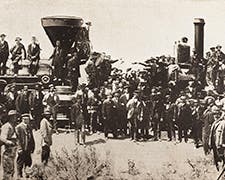The Use of Black Powder and Nitroglycerine on the Transcontinental Railroad
The crate had been shipped by steamer from New York City to Panama, across the isthmus via railroad, and then to San Francisco by steamship. It measured two-and-a-half feet square, weighed a little over 300 pounds, and was indistinguishable from thousands of others, except that it leaked an oily substance. The question was not about what was leaking from the crate, but who was at fault for the leak. To settle the dispute, representatives from the steamship company and the consignor, Wells Fargo, met at the latter's office on Montgomery Street. A Wells Fargo employee grabbed a hammer and chisel and began to open the leaking crate. The resulting explosion a little after noon on Monday, April 16, 1866, instantly killed the workers, leveled the Wells Fargo building, and rattled buildings more than a quarter mile away.
Nitroglycerin was a new product in 1866. Discovered by Italian chemist Ascanio Sobrero in 1847 and perfected as a blasting agent by Alfred Nobel in the early 1860s, nitroglycerin was not widely known by the general public until accounts of accidental explosions like the one in San Francisco were printed in newspapers. In its pure, liquid form, the chemical was extremely volatile. On April 3, 1866, 70 crates of nitroglycerin exploded onboard the California-bound steamship European in Aspinwall, Panama, killing 50 people. Two weeks later the nitroglycerin explosion at the Wells Fargo office in San Francisco killed fifteen people. Two days later, six workers were killed along the Central Pacific line in the Sierra Nevada while transporting nitroglycerin. Following the San Francisco explosion, the California legislature banned the transport of liquid nitroglycerin, forcing Central Pacific workers to exclusively use black powder as their only blasting agent.
Made from a mixture of saltpeter, charcoal and sulfur, black powder is produced by pulverizing and mixing the ingredients, then rolling and pressing the material into cakes that are then dried into explosives for specific applications. Black powder was first brought to California in the late 1840s when miners used the explosive in their search for gold. At that time there were no local factories producing black powder. The miners relied on powder shipments from eastern U.S. and European companies. As the Civil War loomed in the U.S., it became a coveted commodity and the once reliable shipments became more scarce as the North and South stockpiled black powder in the event of war. By the time the Civil War began in April 1861, miners found themselves in desperate need of explosives, and John Baird, a miner from Kentucky, recruited investors to establish the California Powder Works factory near Santa Cruz, California. Up and running by 1864, the Powder Works factory was the sole manufacturer of black powder in the state. The company employed 275 Chinese workers and within a year produced 150,000 25-pound powder kegs.
From 1866 to 1869, the Central Pacific built 15 tunnels and the Union Pacific built 4 four tunnels on the transcontinental line. The Central Pacific used black power during most of the construction phase of the railroad, but the Summit Tunnel through the highest point of the Sierra Nevada range proved a formidable obstacle that necessitated the use of nitroglycerin. Workers were making slow progress cutting through the granite, and engineers realized it would take well over a year to blast through from end to end using conventional methods. Nitroglycerin was needed, but state regulations prevented its transportation. To abide by the new laws, Central Pacific officials employed chemist James Howden to manufacture the material onsite. The glycerin and nitrate and sulfuric acids could be transported to the railroad construction site with relatively little concern for explosions. Once on site, Howden set up his nitroglycerin shop at Donner Pass and manufactured the chemical on a daily, as-needed basis. It was a simple operation. Howden, working alone, used an old kettle under a makeshift shed. The cost of manufacturing nitroglycerin was relatively cheap. Howden was able to make nitroglycerin at 75 cents per pound. At the height of construction in the Sierra Nevada, Howden produced 100 pounds of nitroglycerin per day.
Working with explosives was dangerous business. It required drilling a hole and placing either black powder or liquid nitroglycerin in the opening and lighting a fuse. Though more dangerous than black powder, Howden's nitroglycerin enabled construction crews to rapidly advance the scale of their work. Despite the volatile nature of the chemical, construction workers found that nitroglycerin had several advantages over black powder: it required fewer and shallower holes than blasting with black powder; its debris required less clean up time; and nitroglycerin worked when wet, unlike black powder. But its most significant advantage was its blasting power. In the Summit Tunnel, nitroglycerin enabled construction crews to increase their progress from 1.18 to 1.82 feet per day with progress in some areas at the bottom of the tunnel increasing from 2.51 to 4.38 feet per day.
A new, safer version of nitroglycerin became available in 1867 when Alfred Nobel licensed his dynamite manufacturing process to a U.S. manufacturer. In August 1867, Julius Bandmann incorporated the Giant Powder Company and began manufacturing dynamite in March 19, 1868, too late to be of use by the Central Pacific Railroad. Following the completion of the transcontinental railroad, Howden continued his work with nitroglycerin for California Powder Works which had begun to focus its resources on dynamite production. Howden developed a brand of dynamite the company named Black Hercules, utilizing black powder as an absorbing agent for the nitroglycerin. Giant Powder Works, licensee of Nobel's dynamite patent, sued California Powder for infringement, ultimately losing the court battle.

